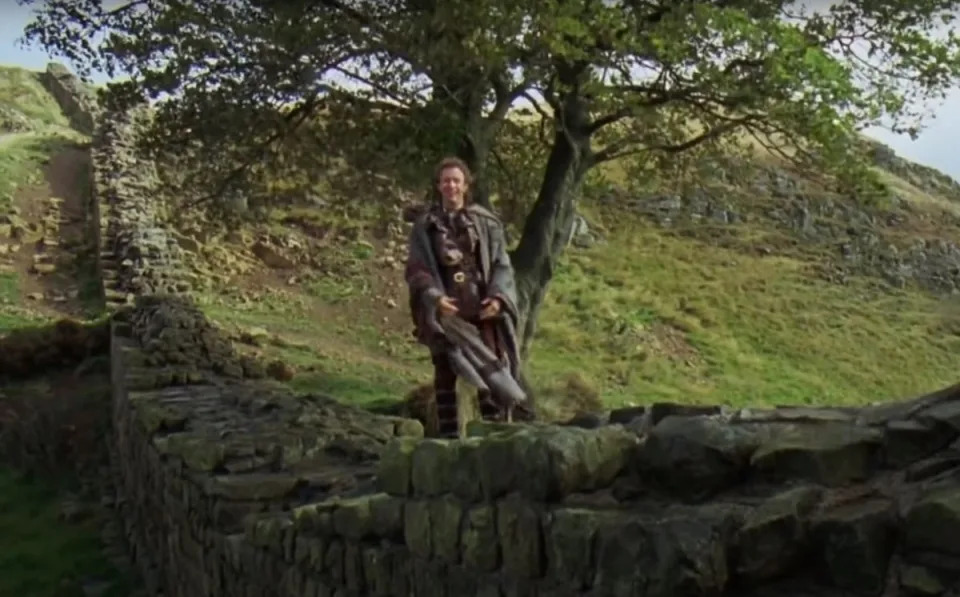Sycamore Gap tree ‘stored in secret location over souvenir hunter fears’
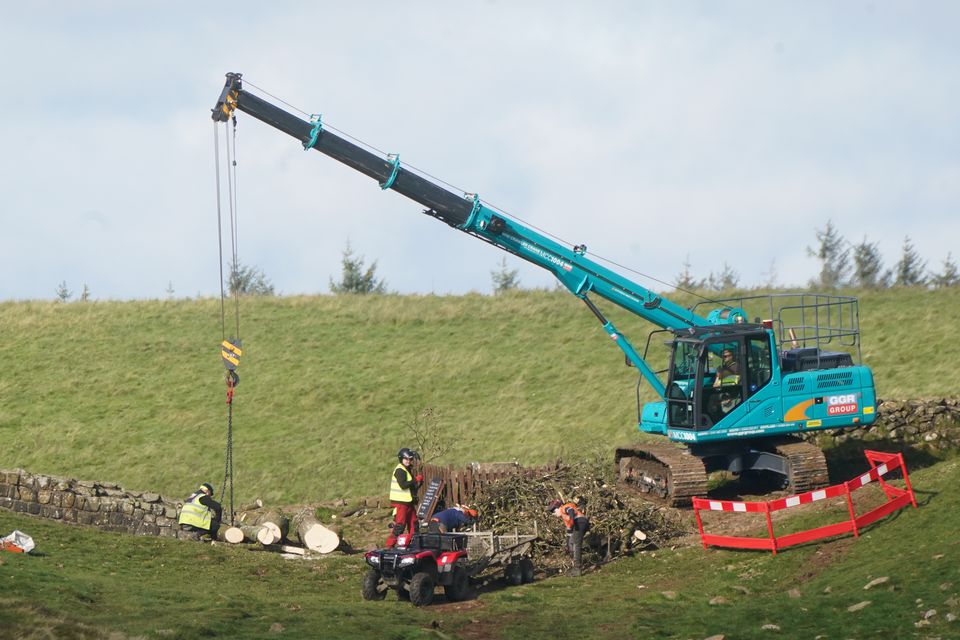
(Owen Humphreys/PA)
By Luke O'Reilly, PAToday
The Sycamore Gap tree is being stored in a secret location to protect it from souvenir hunters, it has been reported.
According to the Sunday Times, police caught several members of the public trying to take pieces of the tree from the site where it was felled near Hadrian’s Wall in Northumberland.
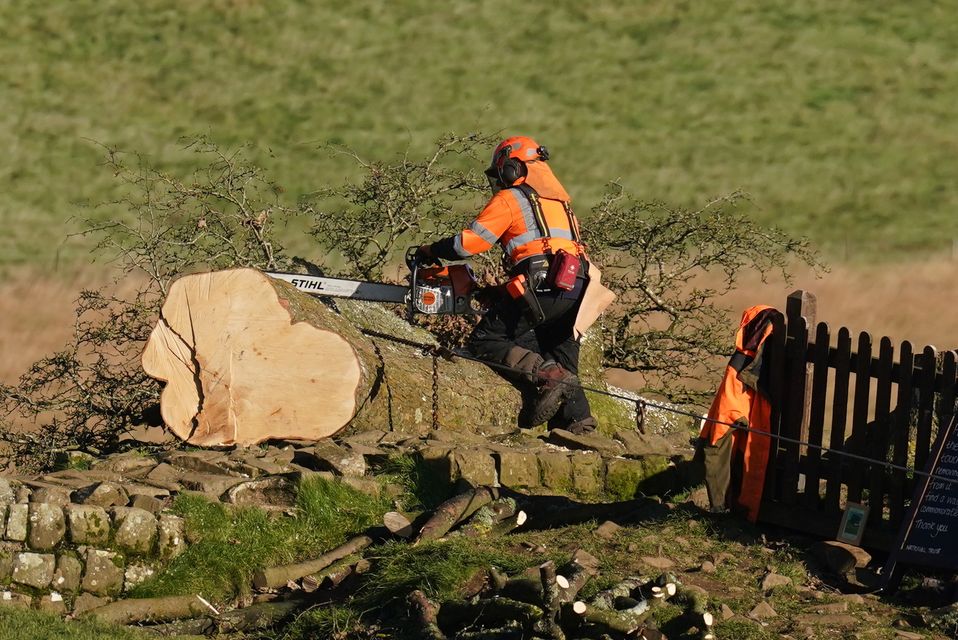
The National Trust has asked the public for suggestions on what to do with the leftover wood from the felled tree (Owen Humphreys/PA)
The tree has since been removed from the site by a crane, and is now being kept at a storage facility by the National Trust.
Much-photographed and painted, the lone sycamore is considered to be one of the most famous trees in the world and an emblem for the North East of England.
It was situated in a dramatic dip in the Northumberland landscape.
Lady Jane Gibson, chairwoman of the Hadrian’s Wall Partnership, told the Sunday Times: “The wood from the tree has been taken away and stored for safekeeping at a secure location.
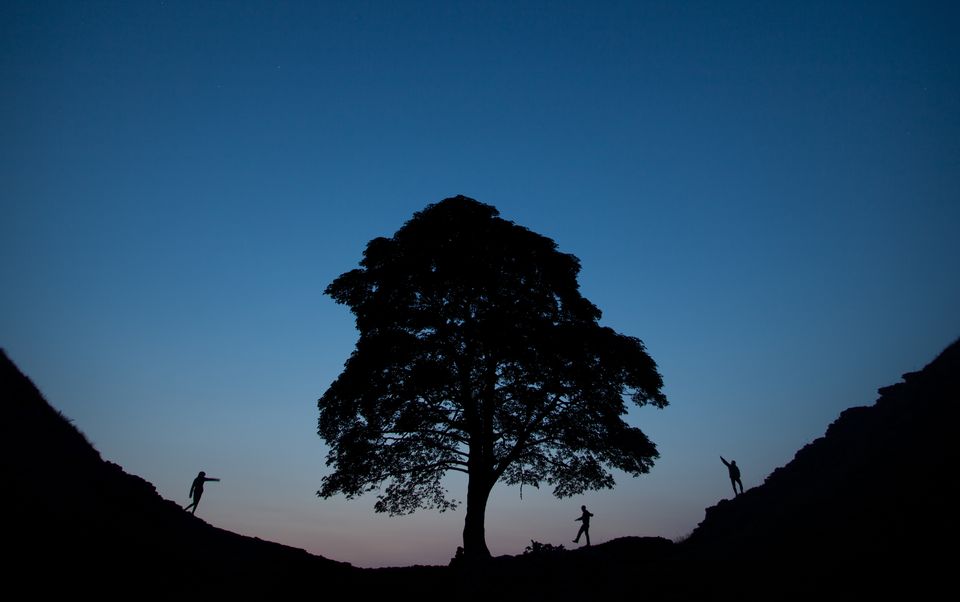
Much-photographed and painted, the lone sycamore is considered to be one of the most famous trees in the world and an emblem for the North East of England (Tom White/PA)
“There were concerns people were taking pieces of it for mementoes, like what happened with the Berlin Wall, when people would take a piece as a keepsake.
“It is now being safely stored as we work on potential future uses for the timber.”
The National Trust has asked the public for suggestions on what to do with the leftover wood from the felled tree, with options including turning it into a bench where the tree once stood, or even making it into pencils.
Sycamore Gap: Using legacy of Hadrian's Wall tree to save others
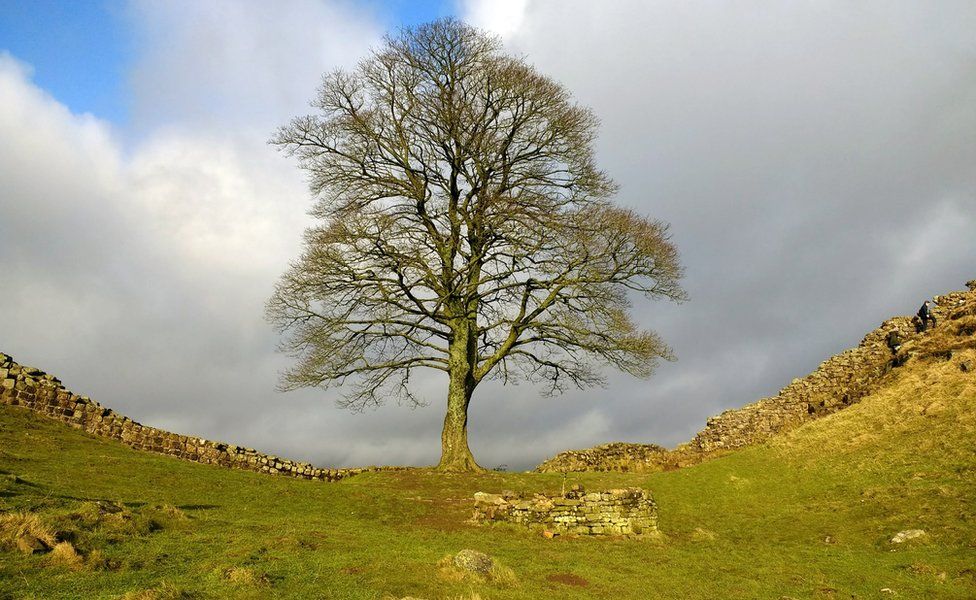 FRANCESCA WILLIAMS
FRANCESCA WILLIAMSThe felling of the Sycamore Gap tree sparked an outpouring of emotion from millions of people. Ecologists are now wondering if they can harness that "grief". Could the tree's lasting legacy be improving the future of our woodlands?
It has been almost a month since the world-famous Sycamore Gap tree, which once sat next to Hadrian's Wall, was deliberately cut down.
After it was chopped up and removed from its site last week, the National Trust said it was "time to start talking about the future".
But for ecologists studying thousands of other trees, the future of the UK's woodlands is looking uncertain, and now they are hoping this one tree could trigger more interest in saving others under threat.
 PA MEDIA
PA MEDIA"I think that it's important to harness the grief over the Sycamore Gap tree to motivate people to take positive environmental action," Dr Julie Urquhart, associate professor in environmental social science at the University of Gloucestershire, said.
"Sadly, the senseless destruction of this globally, culturally-important tree is also a symbolic reminder of humanity's wider destruction of nature through human-induced climate change, deforestation, overpopulation and pollution."
British Ecological Society experts recently warned that the UK's woodland cover had become "highly fragmented", while the Woodland Trust said ancient woodland now covered just 2.5% of the UK.
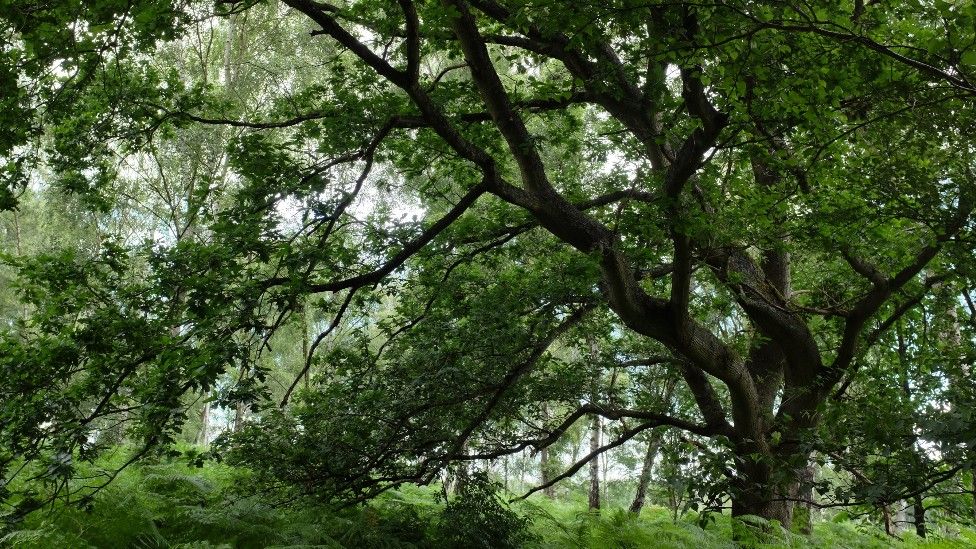
"The UK is one of the least wooded countries in Europe. It has around 13% forest cover, compared to an average of 38% across Europe as a whole and 31% worldwide," Dr Urquhart said.
"This is partly due to the UK's population density and the many competing demands on land cover, particularly agriculture, housing and transport," she added.
Of the 13% cover, about half is made up of native tree species, such as oak, beech and ash, the remaining half comprises non-native trees, such as conifers grown commercially for timber.
In 2021, a review of the state of Britain's native woods and trees found only 7% were in a good condition.
 JULIE URQUHART
JULIE URQUHARTDr Urquhart said that although woodland cover had increased from an all-time low of 5% in the 1900s, woodlands were often placed far apart from each other.
"This makes it very difficult for animal and plant species to move between those patches of woodland - it can also lead to a loss of genetic diversity due to inbreeding," Dr Urquhart continued.
In the 2021 review, a decline in wildlife in ancient woodland was reported by the Woodland Trust, which added that many of these areas were in "poor ecological condition".
The pear tree in Cubbington was felled to make way for HS2
The trust said the UK's trees and woodlands were under threat from a number of factors including climate change, pollution and attack from deadly tree diseases and pests.
It reported that more than 1,000 irreplaceable ancient woods had been threatened by development since 2013.
The trust pointed to the Cubbington pear tree, thought to be more than 250 years old, which was chopped down in Warwickshire to make way for the HS2 rail line in 2020.
The British Ecological Society's president Prof Yadvinder Malhi, who specialises in ecosystem science at the University of Oxford, said that with each passing generation, "our collective memory of the species that once called our land home dwindles".
"The outpouring of emotion around the felling of the Sycamore Gap tree in such a beautiful setting shows the powerful potential connection that we have with nature, its loss and its recovery," he said.
"But it is also important to note that this tree sits in a landscape that has lost so much biodiversity over the years - to which we can be oblivious.
"We don't know what 'good' nature looks like anymore."
 BRITISH ECOLOGICAL SOCIETY
BRITISH ECOLOGICAL SOCIETYHowever, Prof Malhi said there was still "so much potential for the UK landscape and its biodiversity to flourish and be far richer than it is".
"The grassland areas in the UK still contain much valuable biodiversity, but a mosaic landscape with both more trees and grassland could be so much more ecologically vibrant," he added.
Now the question remains - How do we make up for this loss? Can we plant more trees? It is a question seen hundreds of times, especially in the aftermath of Sycamore Gap.
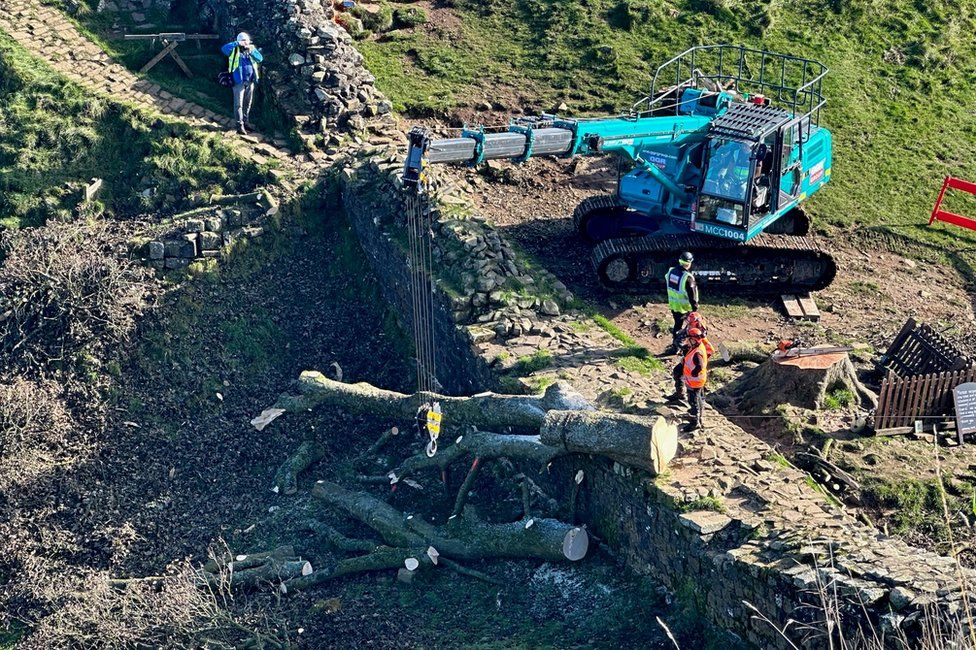
Dr Urquhart said that while expanding tree cover in the UK was important, efforts should be concentrated on saving our native species.
"Even if they are located in areas that are earmarked for new housing or roads or other developments, we urgently need to put in better safeguards to protect trees," she said.
"The real challenge is how do you replace such a culturally important and valued tree, like Sycamore Gap, which has taken hundreds of years to grow.
"I think this spotlights a really important issue - even planting hundreds of new trees won't replace the cultural relevance of this one tree."
Dr Urquhart asked people to look at the national tree wardens scheme, where people can sign up as a volunteer to plant, protect and promote their local trees.
"Local planning authorities are also responsible for Tree Preservation Orders (TPO) that protect certain trees of value within the authority," she said.
"You don't have to own the land a tree sits on to apply for a TPO, if it is in good health and is of visual importance viewing from public areas."
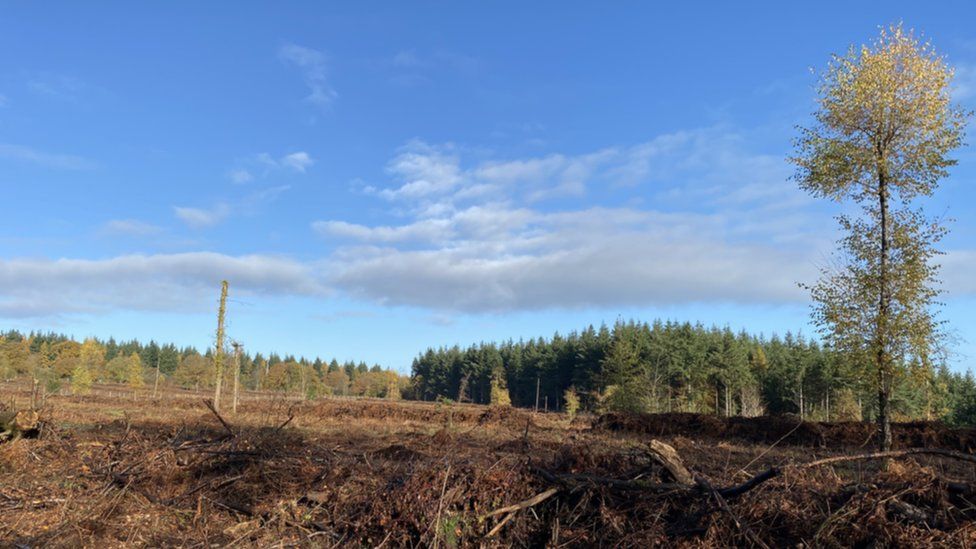 FORESTRY ENGLAND
FORESTRY ENGLANDMeanwhile the Woodland Trust has urged people to take a look at its campaign to grant ancient trees legal protection.
"Most ancient trees have no real legal protection in the UK," the charity's lead campaigner Jack Taylor said.
"They deserve the same sort of protection enjoyed by old buildings and other endangered wildlife."
The trust described UK woodland as "cathedrals of nature" which should be "treated like national treasures".
The reaction to Sycamore Gap's demise showed many people do feel that way. The Northumberland landmark was more than 100 years old so we will not see a full replacement in our lifetime.
It now remains to be seen whether it can instead grow a greater interest for woodlands teetering on the brink of destruction.

